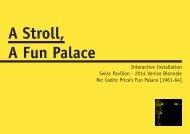India Booklet
This booklet is an assemblage of the sketchbook compiled by Sandro Marpillero together with the photographs taken by Sonal Beri in the course of five days during their Trip to India. Both sketches and photos are limited to the sites visited using as a base the cities of Ahmedabad (3 days -including the meeting with Balkrishna Doshi) and Jaipur (2 days).
This booklet is an assemblage of the sketchbook compiled by Sandro Marpillero together with the photographs taken by Sonal Beri in the course of five days during their Trip to India. Both sketches and photos are limited to the sites visited using as a base the cities of Ahmedabad (3 days -including the meeting with Balkrishna Doshi) and Jaipur (2 days).
You also want an ePaper? Increase the reach of your titles
YUMPU automatically turns print PDFs into web optimized ePapers that Google loves.
1
2
3
4
5
6
7
8
9
10
11
12
13
14
15
16
17
18
19
20
21
22
23
24
25
26
27
28
29
We meet with Balkrishna Doshi at his studio, Sangath, on the third day of our visit to
Ahmedabad. The aging Master has just received the Padma Bhushan Award, one of the
maximum honors in India, having already been awarded the Pritzker Prize in 2018.
He graciously makes himself available for a full hour, reaching us from his residence, Kamala
House. We recount the enthusiasm felt while visiting historical “step-wells” around the city of
Ahmedabad, and how these structures resonate with a larger set of interests. We talk about
the themes of the Workshop at Anant University, centered on the relationship between a
systemic reading of the regime of waters in agricultural land (like in most of Gujarat Region),
and the exploration of its poetic dimension through architecture. He incites us to keep on with
this research, opening up the horizon of a search for adequate institutional and financial
support.
The following notes summarize the core of our conversation.
What we are learning through these visits is the importance of the step-wells. They were all done by women,
funded by women. Not only that. They were also made in support of women to go out by themselves. So the
question was: how far can they go? Would somebody else need to follow them? Would the men have to come?
So then they decided: maybe we should make it like a social place. And, all of a sudden, there were men and
women going there, and they would all participate in the collection of water. And so this activity became a
center of conversation, discovery, et cetera. And people were willing to go down the steps! Where else can one
find a situation like this?
Although the rains have not gone away, our relationship with the rain has gone away, because we got fond of
ways to make water accessible through technology. So, we intend to get into studying this topic, and get going
for a couple of years in order to find out what could be a way to really get back to this source of knowledge.
30
It's a challenge. There are many smaller cities and towns, which still have the pond, the remnants of water tanks
today. They are still there. And if one were really looking at them and said, all right, now what can we do?
We have been studying this problem from satellite images outside Ahmedabad, like in Dhingda, Otelia and all
those settlements. If one sees a settlement, there is always a pond around there. And if one sees how water is
scattered in the landscape, it becomes clear that there is a logic to the distance in-between those settlements,
and that there are agricultural fields, realizing how important the pond was, not just for collecting but for
recharging the aquifer. This tied to agriculture, because of the kind of crops that one could grow. And from what
we understand, there is a very hardy variety of wheat that needs very little irrigation, which is again getting
erased.
One could relate this to the patterns of urban growth, the issues of habitation, the number of people living there,
ways of water collection. Then the connection with humans would raise the question of how to transform the
current sewage system, towards recreating a more sophisticated network in relation with the role of rain and
water. Re-establishing that link. That is what we intend to develop: the systemic and poetic sides of water, as
opposed to the way in which water is looked at from an engineering perspective.
We are talking about a phenomenon that may seem to be limited to a few meters from the surface of earth. yet
it is not talked about for its implications in the society at a larger, deeper, philosophical level. This would require
significant changes, raising substantial questions. So it's not just about Ahmedabad, it's like a bigger system.
And yet, this conversation is not just about water. Its operative horizon is about connecting several institutions
and constituencies together and working on a joint program, maybe not with full money upfront, but at least
starting from some seed. It's like connecting the waters...
31
32
33
34
35
36
37
38
39
40
41
42
43
44
45
46
47
48
49
50
51
52
53
54
55
56
57
58
59
60
61
62
63
64
65
66
67
68
69
70
71
72
73
74
75
76
77
78
79
TABLE OF CONTENTS
Introducon 2
Base: Ahmedabad - 01/26-01/28/2020
- Gandhi Ashram (Charles Correa) 4
- Haveli, Historical Center 8
- Rani-Ki-Vav, Patan 10
- Sun Temple, Modhera 16
- Rudabai Step Well, Adalaj 24
Conversaon with Balkrishna Doshi at his Studio Sanghat on 01/28/2020 28
Base: Jaipur – 02/02-02/03/2020
- Jantar Mantar 34
- City Palace 48
- Amber Fort 54
- Nahargarh Fort Stepwell 60
- Harshshad Mata Temple, Abhaneri 68
- Chaud Baori, Abhaneri 70




